Design Considerations
In order to ensure the fin could be actuated, a target operating depth was determined. Using the generalization that every 10 meters of ocean depth causes a pressure increase of approximately 1 atm, the hydraulic system was designed to operate at depths of up to 20 meters. This generalization assumes water is perfectly incompressible, which is a reasonable simplification at this depth. At 1000m depth, water compresses less than one percent.
Furthermore, research showed that coastal rays live between 0 and 80 feet (0 and 24 meters), spending the majority of their life between 30 and 35 feet (9 to 10.5 meters). This reinforces the choice of target depth. Most coral reefs are less than 150 feet (45 meters) deep, although some extend as deep at 400 feet (122 meters). The current design would require an internal pressure of over 13 atm to safely operate at the 400 ft depth. While this is possible with the correct equipment, limited project budget and time frame make this impractical.
Hydraulic System Layout
A hydraulic system utilizes fluidic pressure to create motion. The hydraulic system is divided into two major loops. The high pressure side feeds from the pump outlet into each valve. From there, the valve can be opened to allow the working fluid under high pressure to enter the fin channel. When the valve closes, the fluid flows out of the fin into the low pressure line. The low pressure line feeds to the pump and the process is repeated.
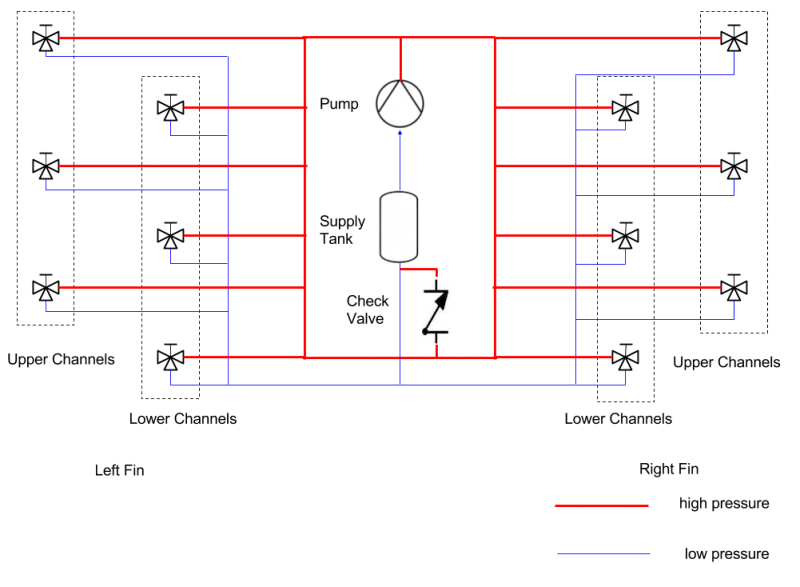
Plumbing Layout
Working Fluid
A hydraulic system requires a working fluid, or any fluid that is contained in the system. This fluid is pressurized, which is translated to mechanical energy through an actuator. The requirements for an ideal working fluid are that the fluid be incompressible, non-combustible, easily contained and with a constant viscosity. An additional consideration for this project was potential environmental impact. This leaves two common choices for working fluids; water and vegetable oil. Water was chosen for this prototype in order to ensure ease of cleanup and availability of parts. Potential risks associated with water as a working fluid include increased cavitation risk and narrower range of operating temperature.
Pump
The pump is what creates pressure in a fluidic system. The pump for this project needed to deliver enough pressure for the robot to operate at the target depth, and be rated for usage with the working fluid. By choosing water, there was no need for a specialty pump, reducing both the price and lead time. The initial choice was a Flojet Demand Pump 1.6 GPM 12V DC 60 psi (FJC-PMP-D3131H5011A).
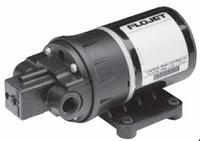
Flojet Pump
The deciding factor in purchasing the pump was how much pressure it could provide. The Flojet pump 60 psi (4.1 atm) allowed for a significant safety margin. Running the pump at maximum pressure constantly can cause early wearing of parts and seals. This model can also run dry for short periods, ensuring the pump will not be damaged by a system leak. Electrical power draw is an important factor for an AUV, limiting choices of pumps further. The initial pump chosen requires 12V DC and draws 7A.
As the largest source of power draw in the project, the pump was a topic of continued research. Clark Solutions in Hudson, MA offered an educational discount on their MG200 gear pump, allowing greater pressure with less overall energy consumption. The MG200 provides up to 290 psi (20 atm) of pressure while requiring 12V DC and drawing 3.4A peak. This resulted in about half the power draw of the Flojet pump, while also being a significantly smaller, lighter, and quieter pump.
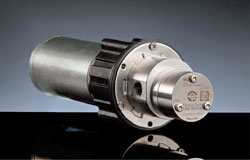
MG200 Gear Pump
Valves
In order to control the pressurization and depressurization of the fin channels, controllable valves are necessary. The options were solenoid valves and motorized valves. Solenoid valves remain in a default state, either open or closed, and require a continuous energy draw to switch and hold the non-default state. Motorized valves require an energy draw to open or close, but can remain in that state with no draw. Solenoid valves are generally smaller and respond more quickly than motorized valves. The desired characteristics of the valve included a low current draw, rated for 60+ psi, and the ability to run off 12V DC. For this system design, a three way valve is required, further reducing valve options. The initial choice was the Misol 3 way motorized ball valve (DN15) due to its low price, availability, 800mA current draw, and ability to fit all other requirements.
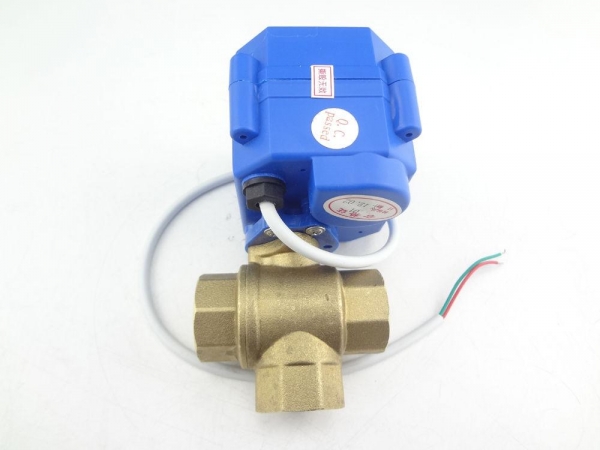
3-Way Valve
Once one of these valves was acquired, it became clear a replacement would be necessary. While some small scale tests proved that the valve worked in the desired fashion, it was too large and heavy when considering twelve valves were needed. The time to switch the direction of the valve also introduced a delay between the desired change and the actual change. The results of these tests lead to the decision to acquire solenoid valves.
The valves used were the drip irrigation 3 way 12V solenoid valve from Ningbo Yaofeng Hydraulic Electrics Company. They are rated for a range of 9 to 150 psi and use 290 mA while holding.
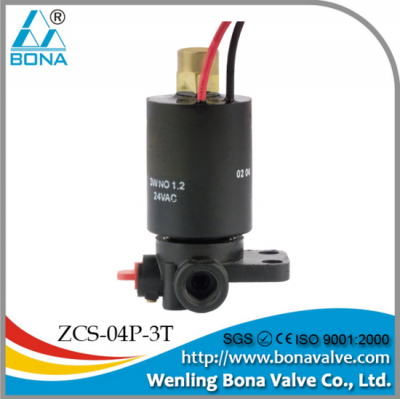
Solenoid Valve
